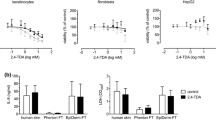Summary
Clotrimazole, an N-substituted imidazole, is a widely used topical agent for the treatment of superficial fungal infections. In this study, the effect of application of clotrimazole to the skin of neonatal rats on the induction response of the cytochrome P-450-dependent monooxygenase system in epidermis and liver has been examined. A single topical application of clotrimazole (10 mg/100 g) to rats resulted in a 53% increase in hepatic cytochrome P-450 content. Clotrimazole treatment also resulted in significant induction of epidermal 7-ethoxycoumarin-O-deethylase activity. Hepatic p-nitrophenol hydroxylase, an enzyme, catalyzed principally by the ethanol inducible cytochrome P-450 isozyme, was also significantly induced (58%) by topically applied clotrimazole. This enzyme activity was undetectable in epidermal microsomes. Further characterization of the cytochrome P-450 isozymes induced in liver by clotrimazole treatment was based on monoclonal antibodies (MAbs) raised against purified rat liver cytochrome P-450 isozymes induced by phenobarbital (MAb 2-66-3) and ethanol (MAb 1-98-1). Hepatic microsomes prepared from clotrimazole-treated rats showed significant immunoreactivity on Western blot with both the MAbs whereas no reactivity occurred in epidermal microsomes. Our data indicate that topical application of clotrimazole to rats results in the induction of selected cytochrome P-450 isozyme(s) in liver and epidermis which may have implications for the therapeutic use of this compound.
Similar content being viewed by others
References
Bickers DR, Dutta-Choudhury T, Mukhtar H (1982) Epidermis: a site of drug metabolism in neonatal rat skin. Studies on cytochrome P-450 content and mixed-function oxidase and epoxide hydrolase activity. Mol Pharmacol 21:239–247
Black SD, Coon MJ (1986) Comparative structures of P-450 cytochromes. In: Ortiz de Montellano PR (ed) Cytochrome P-450: structure, metabolism and biochemistry. Plenum Press, New York, pp 161–216
Epstein EH Jr, Munderloh NL, Fukuyama K (1979) Dithiothreitol separation of newborn rodent dermis and epidermis. J Invest Dermatol 73:207–210
Greenlee, WF, Poland A (1978) An improved assay of 7-ethoxycoumarin-O-deethylase activity: induction of hepatic enzyme activity in C57BI/6J and DBA/2J mice by phenobarbital, 3-methylcholanthrene and 2,3,7,8-tetrachlorodibenzo-p-dioxin. J Pharmacol Exp Ther 205:596–605
Khan WA, Kuhn C, Merk HF, Park SS, Gelboin HV, Bickers DR, Mukhtar H (1989) Isozyme specific monoclonal antibody directed assessment of induction of hepatic cytochrome P-450 by clotrimazole. Drug Metab Dispos 17 (in press)
Ko IY, Park SS, Song BJ, Patten C, Tan Y, Hah YC, Yang CS, Gelboin HV (1987) Monoclonal antibodies to ethanol-induced rat liver cytochrome P-450 that metabolizes aniline and nitrosamines. Cancer Res 47:3101–3109
Kohler G, Milstein C (1975) Continuous cultures of fused cells secreting antibody of predefined specificity. Nature (Lond) 256:495–497
Koop DR (1986) Hydroxylation of p-nitrophenol by rabbit ethanol-inducible cytochrome P-450 isozyme 3a. Mol Pharmacol 29:399–404
Koop DR, Crump BL, Nordblom GD, Coon MJ (1985) Immunochemical evidence for induction of the alcohol-oxidizing cytochrome P-450 of rabbit liver microsomes by diverse agents: ethanol, imidazole, trichloroethylene, acetone, pyrazole, and isoniazid. Proc Natl Acad Sci USA 82:4065–4069
Laemmli UK (1970) Cleavage of structural proteins during the assembly of the head of bacteriophage T4. Nature (Lond) 227:680–685
Lowry OH, Rosebrough NJ, Farr AL, Randall RJ (1951) Protein measurement with Folin-phenol reagent. J Biol Chem 193:265–275
Merk HF, Mukhtar H, Kaufmann I, Das M, Bickers DR (1987) Human hair follicle benzo(a)pyrene and benzo(a)pyrene 7,8-diol metabolism: effect of exposure to a coal tar containing shampoo. J Invest Dermatol 88:71–76
Mukhtar H, Bickers DR (1981) Drug metabolism in skin: comparative activity of the mixed-function oxidases, epoxide hydratase, and glutathione-S-transferase in liver and skin of the neonatal rat. Drug Metab Dispos 9:311–314
Mukhtar H, DelTito BJ, Das M, Cherniack EP, Cherniack AD, Bickers DR (1984) Clotrimazole, an inhibitor of epidermal benzo(a)pyrene metabolism and DNA binding and carcinogenicity of the hydrocarbon. Cancer Res 44:4233–4240
Omura T, Sato R (1964) The carbon monoxide-binding pigment of liver microsomes. I. Evidence for its hemeprotein nature. J Biol Chem 239:2370–2378
Park SS, Fujino T, Miller H, Guengerich FP, Gelboin HV (1984) Monoclonal antibodies to phenobarbital-induced rat liver cytochrome P-450. Biochem Pharmacol 33:2071–2081
Park SS, Miller H, Klotz AV, Kloepper-Sams PJ, Stageman JJ, Gelboin HV (1986) Monoclonal antibodies to liver microsomal cytochrome P-450E of the marine fish Stenotomous chrysops (scup): cross reactivity of 3-methylcholanthrene-induced rat cytochrome P-450. Arch Biochem Biophys 249:339–350
Ritter JK, Franklin MR (1987) Induction and inhibition of rat hepatic drug metabolism by N-substituted imidazole drugs. Drug Metab Dispos 15:335–342
Ritter JK, Franklin MR (1987) Clotrimazole induction of cytochrome P-450: dose differentiated isozyme induction. Mol Pharmacol 31:135–139
Ritter JK, Franklin MR (1987) High magnitude hepatic cytochrome P-450 induction by an N-substituted imidazole antimycotic, clotrimazole. Biochem Pharmacol 36:2783–2787
Ryan DE, Koop DR, Thomas PE, Coon MJ, Levin W (1986) Evidence that isoniazid and ethanol induce the same microsomal cytochrome P-450 in rat liver, an isozyme homologous to rabbit liver cytochrome P-450 isozyme 3a. Arch Biochem Biophys 246:633–644
Schuetz EG, Wrighton SA, Safe SH, Guzelian PS (1986) Regulation of cytochrome P-450p by phenobarbital-like inducers in adult rat hepatocytes in primary monolayer culture and in vivo. Biochemistry 25:1124–1133
Thomas PE, Bandiera S, Maines SL, Rayan DE, Levin W (1987) Regulation of cytochrome P-450 j, a high affinity N-nitrosodimethylamine demethylase, in rat hepatic microsomes. Biochemistry 26:2280–2289
Towbin H, Staethlin T, Gordon J (1979) Electrophoretic transfer of proteins from polyacrylamide gels to nitrocellulose sheets. Proc Natl Acad Sci USA 76:4350–4354
Welsh O, Rodriguez M (1980) Treatment of dermatomycoses with ketoconazole. Rev Infect Dis 2:582–585
Wiekinson CF, Hetnarski K, Yellin TO (1972) Imidazole derivatives — a new class of microsomal enzyme inhibitors. Biochem Pharmacol 21:3187–3192
Wrighton SA, Mantel P, Schuetz EG, Watkins PB, Young B, Guzelian PS (1985) Identification of the clotrimazole induced by macrolide antibiotics in rat liver as the glucocorticoid responsive cytochrome P-450p. Biochemistry 24:2171–2178
Author information
Authors and Affiliations
Additional information
This study was supported in part by USPHS Grant ES-1900 and by research funds from the Veterans Administration
Rights and permissions
About this article
Cite this article
Merk, H.F., Khan, W.A., Kuhn, C. et al. Effect of topical application of clotrimazole to rats on epidermal and hepatic monooxygenase activities and cytochrome P-450. Arch Dermatol Res 281, 198–202 (1989). https://doi.org/10.1007/BF00456393
Received:
Issue Date:
DOI: https://doi.org/10.1007/BF00456393




